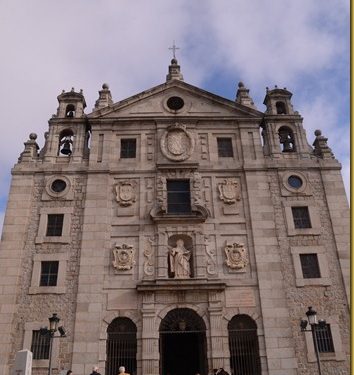
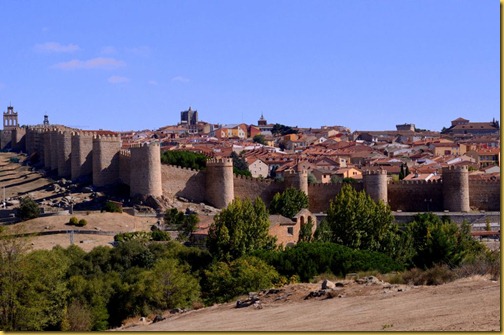
It is the early afternoon. I am standing in front of a little shrine called Los Cuatro Postes or The Four Posts where four pillars encloses a cross. I climb up a short flight of steps and look out into the vast open space from the shrine. In the immediate distance lies an entire town enclosed by massive granite walls. Towering and formidable, these walls rise above the ground to touch the dark gloomy sky pregnant with droplets of rain. Tinged with a shade of brown ochre, the walls are intact and they look aesthetic as their flat surfaces are interrupted by a series of semi-circular turrets, adding a geometric pattern to them. Standing tall at 12 metres, these brown walls are punctuated with nine gates built across the length of 2.5 kms, with 88 towers that give the city its stony look.
It feels a bit mysterious to live in a town that is almost completely surrounded by these stone walls. I shiver a bit in the cold, lost in a land that seems to be out of a fairy tale, dwarfed by these imposing structures. But there is a beauty in the barrenness. As I am admiring the view, a newly married couple lock lips and pose for a wedding portrait against the backdrop of the town
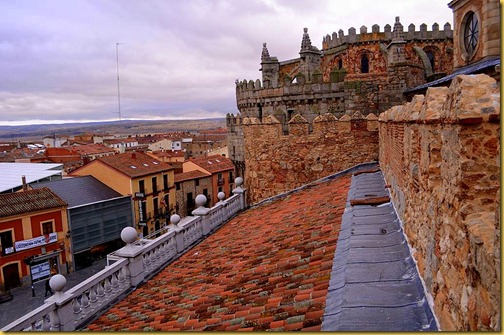
Ringed in by the Sierra Gredos mountains, Avila in Spain is a Roman town perched on a rocky outcrop on the banks of the Adija River in Spain. Often referred to as the land of saints and stones with the Gothic and Romanesque churches dotting its landscape, Avila is a UNESCO World Heritage City that looks lost in a dreamy stupor of the past. The walls, built in the Middle Ages are virtually the symbol of the town, visible from almost any part of Avila.
Avila however has had a war torn history prior to the construction of its impregnable walls. It was the home of the Celtic tribes known as “Vettones” around the 5th-7th centuries BC and was called the Obila or the High Mountain then. The Romans invaded it around the 1st century AD and called it Abila and ruled for almost six centuries.
However it became a war zone during the Middle Ages between the 7th – 11th centuries with frequent wars between the Islamic Moors and the Christian kingdoms leading to Avila becoming a ghost town eventually. Avila was finally repopulated under the reign of Raymond of Burgundy in the 11th century who ordered the construction of these walls to protect it from further attacks .Ever since they have remained as a strong formidable presence in the town, keeping all invaders at bay.
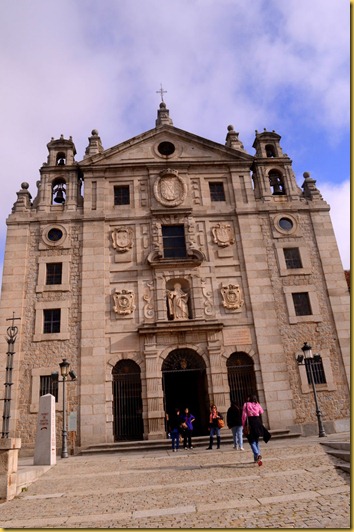
However Avila has a mystical side as well. It was home to several saints, including St Theresa of Jesus, the 16th century patron saint of Avila who had reformed the Carmelite Order across Spain. And my guide, Blanca shares a little anecdote from her life that took place at The Four Postes. St Theresa ‘s childhood was rather dramatic. She had visions of Christ besides being tormented by The Devil. When she was barely seven , she was planning to run away with her brother and fight for her state against the Moors. It is believed that her uncle stopped her right here at the Four Posts, just as she was planning her escape . St Theresa however grew up to become a reformist and started spreading her faith, not just in Avila but across Spain as well.
The sky suddenly turns blue as dreamy clouds appear, pushing the rain away. Done with the introduction to the city, I now move on to explore the two key facets of the town – the stones and the saints that give Avila its identity.
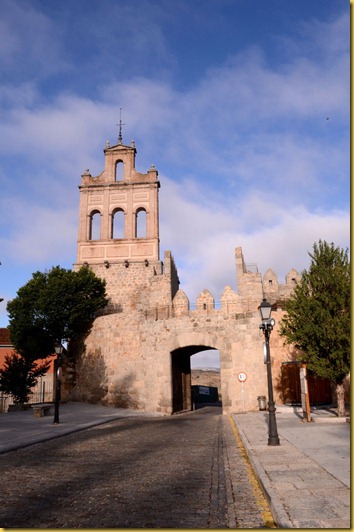
I start with a journey up the walls. There are several routes and I begin at the Puerta Del Carmen , or the Gate of El Carmen, that takes its name from a Carmelite convent attached to the walls . I walk right atop the wall, along the entire length, only to see them stretching endlessly for miles.. The town now wears a fresh coat of paint as Avila shows me her true colours. Huddled below are several pink, white and red houses looking petite as the walls wrap them in their folds. As we look down the sloping roof while palaces and cathedrals dot the landscape, my guide , Blanca shows me some stone sculptures of bulls or boars carved on the surface of the walls that date back to a period before the Romans arrived. Standing there, I am lost in my thoughts, with the wind blowing right into my face. I imagine it during the medieval era when knights guarded their fortresses and horse hoofs trotted in the distance.
I am back on the cobbled streets that take me into palaces, monasteries, chapels and churches. I stop by at The Cathedral of Avila, built between the 11th-12th centuries in the Gothic style of architecture, around the same time when the city was fortified. Built with granite, it is looks like a fortress with its apse shaped like a turret as it forms a part of the city walls, probably reflecting the history of the era where battles were raged constantly.
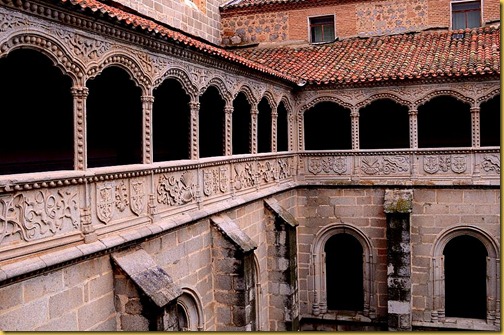
Another monument that draws me is the Santo Thomas Royal Monastery, built in the 15th century in a Gothic style. With three elegant cloisters, built across two storeys, the monastery holds the tomb of Prince Don Juan, the crown prince of King Ferdinand and Queen Isabella, who are best known for sponsoring Christopher Columbus’ voyage . While the marble crypt remains, the guide tells us that tomb is empty as his remains were desecrated during one of the wars.
Our next stop is a small shrine that Avila is proud of. The sky gets gloomy again, but in that grey atmosphere, a colourful toy train chugs along bringing in a group of tourists through one of the many city gates. The train, taking the tourists through the nine gates of Avila finally stops in front of a 17th century convent, which was once the home of St Theresa, the saint and writer who travelled from Avila to all over Spain reforming the Carmelite Order. Built after her canonisation, the convent is closed to the public, but tourists can visit the chapel located inside the Baroque church.
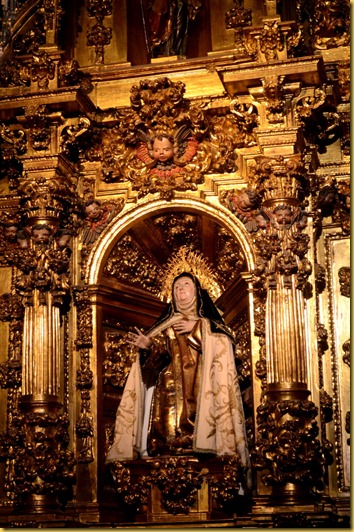
We walk in to see her relics and amidst the rosary and other personal effects, is a fragile finger with a ring is placed there as well. It is believed to be her finger from the right hand. But it is not just the relics. The silence in the chapel draws me like a magnet as I sit there for a while inside a reconstructed version of a cell where she prayed.
I move on to a livelier part of Avila. The city square is vibrant and is thronged with tourists. Avila’s proximity to Madrid (it takes barely a couple of hours by road) and its World Heritage status seems to draw a lot of them here. Little surprises spring on me as I wander around aimlessly. A South American, from Argentina wearing a bright colourful costume plays a guitar and entertains the locals. In the square a young choir group is in the midst of an energetic performance of hymns. Elsewhere a little bit of India is tucked away in a small souvenir shop called The Taj Mahal.
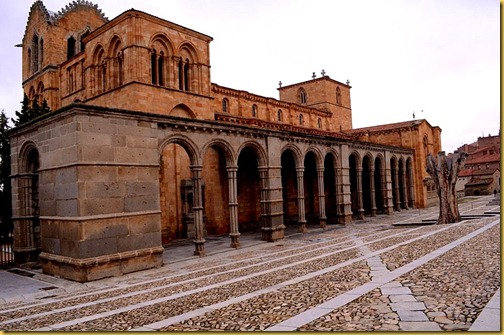
It is almost dusk and darkness descends on Avila within minutes, even as the city glows in a spectacular display of lights as the walls and the monuments are lit. I walk along the tiny cobbled lanes running into statues of saints. Bells greet me in every corner. I shiver in the cold as the stars come out into the sky. It is a surreal moment. The outlines of the walls stand out reassuringly against the dark sky, as silence wraps the ancient town in a thick blanket. Every lane leads to a little piece of history. Legends are written in small sculptures that are tucked away in the corners. And St Theresa greets me everywhere – on names of squares and streets.
My last stop at Avila in Spain is a quaint sweet shop that serves the traditional sweet made of egg yolk that goes by the name of “Yemas de Santa Theresa” . As I bite into the juicy piece of dessert, I see more sweet shops on the way and the road finally leads me back to the walls .
A version of this story was published in HT Mint.

It seems to be the wonderful town. Nice to know about it. Thanks for the share.
Hello Lakshmi,
This is a really lovely blog. I have really enjoyed reading through your interesting and informative posts. You describe some great adventures here ad provide beautiful pictures from the places you visit to complement the narrative. I really like it. I think I could help to get you some extra exposure by increasing this blog’s readership if you are interested?
I am searching for passionate writers to join our community of bloggers – glipho.com
Please check us out and drop me a line at [email protected] for any questions.
Best!
Hubert
Nice story! Spain seems to be rich with history.
http://renuka-mytraveldiary.blogspot.in
These brick-walled structures still seem to be standing strong. It’s almost as if they were built only recently.
Quite a well-written piece, Lakshmi.
Very informative and useful blog. Really appreciate able and very well narrated. Great photography creative and innovative photographs.. I love to follow this blog.
Nice post very informative. It seems that history of Spain is very colorful.. Btw love the pictures as well…